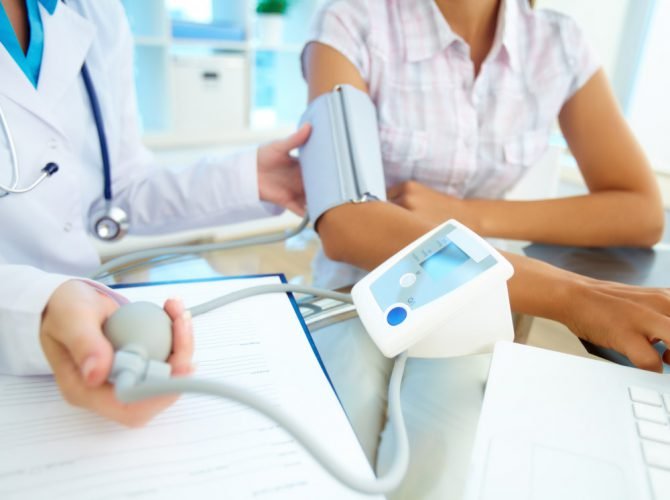Overview
A blood pressure test measures the pressure in your arteries as your heart pumps. You might have a blood pressure test as a part of a routine doctor’s appointment or as a screening for high blood pressure (hypertension). Many people, such as those with high blood pressure, do their own blood pressure tests at home so that they can better track their health.
You may have more frequent blood pressure tests if you’ve been diagnosed with elevated blood pressure, high blood pressure (hypertension) or low blood pressure (hypotension).
Why it’s done
Having a blood pressure test is a routine part of most medical appointments.
Your doctor may order separate appointments for repeat blood pressure checks to look for ongoing health conditions, including elevated blood pressure, high blood pressure (hypertension), low blood pressure (hypotension), heart disease or other conditions.
You should have a blood pressure test performed at least once every two years to screen for high blood pressure as a risk factor for heart disease and stroke, starting at age 18. If you’re age 40 or older or if you’re age 18 to 39 with a high risk of high blood pressure, ask your doctor for a blood pressure reading every year.
Your doctor may recommend screening at a younger age if there are additional risk factors for developing heart disease, such as being overweight or having a family history of high blood pressure or heart disease. If you’ve already been diagnosed with high or low blood pressure, you should have blood pressure tests more frequently.
Even if your doctor doesn’t think you have high or low blood pressure as an ongoing condition, your blood pressure is important information for your doctor. It can provide information about your general health.
Your doctor may recommend that, in addition to regular blood pressure tests at a doctor’s office, you perform blood pressure tests at home. There are automated home blood pressure monitors that are easy to use.
Risks
Having a blood pressure test doesn’t pose any risks to your health. The squeezing of an inflated blood pressure cuff on your arm may be uncomfortable, but it should last only a few seconds.
Occasionally a few tiny red painless spots (petechia) appear after the test just below the location of the cuff, especially if you are taking anti-platelet drugs.
How you prepare
No special preparations are needed for a blood pressure test. You might want to wear a short-sleeved shirt to your appointment so that the nurse or technician doing your blood pressure test has easy access to your arm to perform the test.
However, if the main reason for your doctor’s appointment is to check for or monitor high blood pressure, you should use the toilet before your test to empty your bladder, and avoid eating, drinking caffeinated beverages and smoking for one hour before your test.
Because some medications — such as over-the-counter cold medicines, nonsteroidal anti-inflammatory drugs (NSAIDs), antidepressants, birth control pills and others — can affect your blood pressure, it’s a good idea to take a list of medications and supplements you use to your doctor’s appointment. Don’t stop taking any prescription medications that you think may affect your blood pressure without your doctor’s advice.
What you can expect
During the procedure
Having a blood pressure test is often a routine part of a medical appointment. The test may be performed by a nurse or technician.
The test is performed best while you’re seated in a chair in the examining room. Your arm should be supported, resting on a table at heart level, both feet flat on the floor and back supported by the chair.
Your nurse or technician will wrap an inflatable cuff around the top part of your arm so that the bottom of the cuff is just above your elbow. The cuff is attached to a dial, digital display or a device that looks similar to a thermometer. This equipment is called a sphygmomanometer (sfig-moe-muh-NOM-uh-tur).
Your nurse or technician will generally check blood pressure in both arms to determine if there is a difference. It’s important to use an appropriate-sized arm cuff and a properly calibrated device.
Throughout the test, you should try not to talk or move your arm. The nurse or technician will feel the pulse at your wrist and then take a reading with the sphygmomanometer, checking for when the pulse is felt as the air deflates from the cuff. This is so he or she can figure out how much air to pump into the cuff to accurately measure your blood pressure.
Once the nurse or technician finds a pulse from an artery, he or she will position the stethoscope above the elbow to listen for the blood flow. Then he or she will begin inflating the cuff with a small hand pump. The nurse or technician will inflate the cuff to momentarily stop the blood flow through the artery in your arm.
Then the nurse or technician will open a valve on the hand pump to slowly release the air in the cuff. He or she will continue to listen to your pulse with a stethoscope to record your systolic and diastolic blood pressure.
Systolic pressure — the top number of your blood pressure reading — is the pressure of the blood flow when your heart muscle contracts, pumping blood. Diastolic pressure — the bottom number of your blood pressure reading — is the pressure measured between heartbeats. Blood pressure is measured in millimeters of mercury, which is abbreviated mm Hg.
It’s also possible your blood pressure will be evaluated using a machine that automatically measures the pressure in your pulse to determine your systolic and diastolic blood pressure. If this is the case, it’s not necessary for the nurse or technician to search for your pulse with a stethoscope.
Whether your blood pressure is measured by hand or with an automatic machine, it takes about a minute to complete a single blood pressure measurement.
After the procedure
The nurse or technician taking your blood pressure can tell you what your blood pressure is immediately after the test is over. Your doctor may discuss what the results mean if your blood pressure test shows that you have high or low blood pressure.
If your doctor thinks you may have high or low blood pressure and is trying to decide the best treatment options for you, you’ll need to have at least three follow-up appointments to have your blood pressure checked. This is because your blood pressure can vary from moment to moment and day to day. Also for this reason, you’ll be given multiple blood pressure tests during one visit. This is most frequently done in a quiet setting with automated devices that record a series of blood pressure measurements over a few minutes and average the values.
Your doctor will look at the results of each of your blood pressure tests to see if you need treatment. You may also be instructed to take several blood pressure readings at home. Check with your doctor to ensure your home blood pressure monitor has been validated. Have your doctor watch you use the device to see if you’re doing it properly. Make sure to use a properly fitting cuff. Once a year, check that your monitor is accurate by bringing it to your doctor’s office and comparing your monitor’s readings with those taken by the doctor. Home blood pressure monitoring isn’t a substitute for visits to your doctor, and home blood pressure monitors may have some limitations.
Tracking your blood pressure readings
It can be helpful in diagnosing or monitoring high blood pressure if you record your readings in a blood pressure log, whether on paper or electronically, such as in an online personal health record or blood pressure tracker, for example. This gives you the option of sharing your data with your health care providers and family members.
Some blood pressure monitors can be connected directly or wirelessly to your computer or cellphone, making it easy to transfer the information to an online record.
Results
You can learn your blood pressure measurement as soon as your test is over. A blood pressure reading, given in millimeters of mercury (mm Hg), has two numbers. The first, or top, number measures the pressure in your arteries when your heart beats (systolic pressure). The second, or bottom, number measures the pressure in your arteries between beats (diastolic pressure).
Here’s a look at the four blood pressure categories and what they mean. If your readings fall into two different categories, your correct blood pressure category is the higher one.
| Top number (systolic) in mm Hg | And/or | Bottom number (diastolic) in mm Hg | Your category* |
|---|---|---|---|
|
|||
| Below 90 | or | Below 60 | Low blood pressure† (hypotension) |
| Below 120 | and | Below 80 | Normal blood pressure |
| 120-129 | and | Below 80 | Elevated blood pressure |
| 130-139 | or | 80-89 | Stage 1 high blood pressure (hypertension) |
| 140 or more | or | 90 or more | Stage 2 high blood pressure (hypertension) |
Elevated blood pressure and stages 1 and 2 high blood pressure (hypertension)
If your blood pressure test shows that you have higher than normal blood pressure, your doctor will recommend that you make lifestyle changes to try to lower your blood pressure.
- Reduce the amount of salt in your diet. The American Heart Association recommends that healthy adults have no more than 2,300 milligrams (mg) of salt (sodium) a day. Most adults ideally should have no more than 1,500 mg of sodium a day.
While you can reduce the amount of salt you eat by putting down the saltshaker, you should also pay attention to the amount of salt that’s in the processed foods you eat, such as canned soups or frozen dinners.
- Eat healthy foods. Choose fruits, vegetables, whole grains and low-fat dairy foods. Eat less saturated fat and total fat.
- If you smoke, quit. You should also try to avoid secondhand smoke.
- Lose weight. If you’re overweight, losing even 5 pounds can lower your blood pressure.
- Exercise regularly. Regular physical activity can help lower your blood pressure and keep your weight under control. Strive for at least 30 minutes of physical activity five days a week.
- Limit alcohol. Even if you’re healthy, alcohol can raise your blood pressure. If you choose to drink alcohol, drink in moderation. This means up to one drink a day for women of all ages and men older than age 65, and up to two drinks a day for men age 65 and younger. One drink equals 12 ounces of beer, 5 ounces of wine or 1.5 ounces of 80-proof liquor.
If lifestyle changes alone aren’t enough, your doctor may recommend medications to help lower your blood pressure. Your doctor will discuss which medication options might work best for you.
Low blood pressure
Low blood pressure that doesn’t cause signs or symptoms or causes only mild symptoms, such as brief episodes of dizziness when standing, rarely requires treatment. If you do have symptoms, the best treatment depends on the underlying cause.













